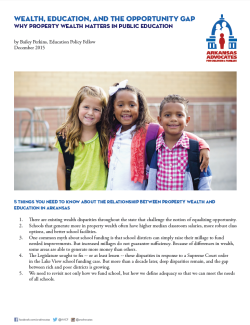
Education has been called “the great equalizer,” because it is a key tool in lifting the working poor out of poverty, decreasing crime, and improving health. Arkansas has made education a priority since statehood. The state’s constitution says the intelligence and virtue gained from education are “the safeguards of liberty and the bulwark of a free and good government.” The General Assembly is tasked with maintaining “a general, suitable, and efficient system of free public schools and [adopting] all suitable means to secure to the people the advantages and opportunities of education.” The constitution clearly says the state’s goal is to “provide quality education and a fair system for the distribution of funds.” But existing wealth disparities throughout the state challenge the notion of equalizing opportunity.
Those differences in wealth filter down to education where the types of classes a student is offered, the tools available to students, and the quality of facilities provided are often determined by where a child lives. These things and others contribute to the “opportunity gap.”
According to the Education Trust, the highest poverty school districts across the country receive 10 percent less per student in state and local funding than the lowest poverty districts. So, how does Arkansas match up?
Our schools are funded in three ways: through property tax assessment at the local level, state general revenue dollars, and federal grant dollars to support different efforts. On the local level, generating money for schools in Arkansas depends on the worth of the property within each school district. Because of population density and vast economic differences, that property wealth varies. So, we start collections on an unequal playing field.
